If you are new here, don’t forget to check our Discord Channel. it’s free for everyone!
If you would like to see more Living End content, including sideboard guide, click here.
Introduction
What is Mono Black Coffers?
Regardless of the exact version, Coffers is a control deck that branches into big mana territory. Your main gameplan is to interact early, be it with removal, discard or land destruction, and use them as a way to bridge into the Karn, the Great Creator/The One Ring endgame. The deck has a level of inevitability similar to Tron, but instead of trying to speed itself up, its aim is to slow down the opponent.
A typical decklist:
Why is it good? What is the best metagame for this deck?
Currently, Modern is full of proactive strategies based around creatures, and Coffers relies on the printings of Orcish Bowmasters and The One Ring to combat them. As long as your interaction spells match up correctly against opponents’ stuff, the deck has a decent matchup. Coffers contain five main axes of interaction:
- Removal (Fatal Push, March of Wretched Sorrow, Orcish Bowmasters, Damnation, Sheoldred’s Edict, Deadly Cover-Up etc)
- Karn, alongside his wishboard
- Non-basic land destruction (Field of Ruin, Demolition Field, Liquimetal Coating, Sundering Titan, Shadow of Doubt)
- Discard (mainly Thoughtseize and any other uncommon discard spells like Inquisition of Kozilek or Collective Brutality)
- Punishing card draw (Orcish Bowmasters and Sheoldred, the Apocalypse)
The more your opponent is affected by a high number of those axes, the better the matchup will be for Coffers. I think the following decks are the best matchups you could hope for among the currently played decks:
- UR Murktide: affected by axes 1, 3, 4, 5 and axis 2 is decent. It’s one of the two best matchups of Coffers, all of your interaction is good and hard to deal with
- Tron: affected by axes 2, 3, 4, 5, not by axis 1. Most of the time, Tron plays against decks which have a low amount of interaction against it, but Coffers can fight against their lands, hand, library and close to any threat
- Hammer and Hardened Scales: affected by axes 1, 2, 3, 4 and not by axis 5. I’m a bit less confident about Hammer than Scales, but they are somewhat similar. The first half of the analysis is similar to Murktide, because most of your interaction is good Karn is very often a gamebreaker, but both decks can present very powerful openings and Coffers doesn’t play any cheap hate against artifacts.
What are the deck’s biggest weaknesses?
As you can guess, when multiple of the aforementioned axes are useless or weak, Coffers have a hard time. Currently, only 2 decks are very rough to play against:
- Living End: removal is bad, Karn is slow and can be countered or discarded, land destruction is useless up to turn 4, they have redundant spells against discard
- Amulet Titan; removal is mediocre, Karn is slow, land destruction is a bit slow too and they have redundant spells
If Coffers is at least a playable deck, it’s because those are the only decks (among the common ones) that force you into bad and polarised games. That doesn’t mean they are not fixable, but the cost of doing so is pretty high (cards like Relic of Progenitus or Shadow of Doubt are very often poor cantrips). Among less popular decks that seem to be very bad matchups, I’d single out any spell-based combo decks (Twiddle Storm, Belcher, Oops All Spells and Storm) and Mill.
An explicit note: that doesn’t mean Coffers have only two bad match-ups, but it does mean that, among the popular decks, these two seem much harder to tune against without making a significant deckbuilding costs that will leave you worse off against the rest of the format.
Maindeck – analysis card by card
The manabase
Cabal Coffers
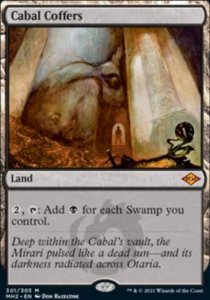
This card is your enabler to act like a big mana deck when you have to. Urborg and the high number of Swamps ensure that you’ll be able to get mileage out of it consistently. It allows you to play four Marches of Wretched Sorrow, expensive payoffs to get with Karn, and big turns ahead of schedule. It should not be dismissed that the card doesn’t produce any mana on its own, which explains the high count of lands. If you need it, you can shortcut the amount of mana produced by all your Swamps and Cabal Coffers (assuming Urborg is in play) in the following way:
- Every Swamp counts as an X+1 mana, where X is the number of Coffers you have
- Every Coffers is essentially -3 mana
It’s important to check the key amounts of mana you need for various payoffs. A couple of examples:
- 7 mana for Ensnaring Bridge against Scam (turn five with Coffers, Urborg and three other lands, turn six with Coffers, four Swamps and one non-Swamp)
- 12 mana for Sundering Titan against slower decks, or Oblivion Stone against Yawgmoth (turn six with two Coffers, Urborg and three others lands, turn eight with Coffers, Urborg and six others lands)
Urborg, Tomb of Yawgmoth
This land is the second piece of your mana engine. Cabal Coffers is functional alone with enough Swamps, but Urborg lets you improve on your mana much earlier than just Coffers themselves. I think the big mana plan of Coffers is one of the reasons why it’s a good deck, so, despite the legendary rule, playing 4 Urborg seems worth it. Some people opt for Expedition Map with fewer Urborgs, but I think that’s too much of a tempo loss to justify. The total number of lands should be correlated to the number of Urborg too, as having a functional manabase when drawing either zero or multiple Urborgs is essential to avoid non-games. There are a couple of upsides to the legendary rule: it triggers Revolt, and fills your graveyard for zero mana. Do not hesitate to play a second Urborg if it helps you to play something.
Takenuma, Abandoned Mire
Considering how many lands the deck runs, playing a few utility lands is fine. The main thing to look for is entering play untapped when you need it, mainly in the early turns. Not being a Swamp, or fetching one, is acceptable with four Urborgs. Takenuma’s main purpose is the ability to rebuy a Karn later in the game. On top of that, it feeds Cling to Dust and offers you an instant speed couple of chump blockers when paired with Bowmasters.
Troll of Khazad-dum
It’s a false non-land card, because most of the time it will be cycled to get a Swamp. The main upsides are increasing the number of black cards to pitch on March of Wretch Sorrow and having a massive creature to cast during grindy games. It gives a small edge against Living End too, and I could see playing a lot of Trolls in a metagame where Living End is very popular. My main issue with the card is that it’s effectively a tapped land, which is quite awful when my goal is to curve out in the early game. However, with the way it improves the manabase, coupled with both the Living End edge and enabling Collect Evidence on Deadly Cover-Up, I think it’s just barely worth it to run it.
Field of Ruin and Demolition Field

One of the few utility lands which can be used by Coffers without sacrificing too many slots for non-Swamps. It’s mostly good against decks based around their lands (Tron, Coffers, Amulet, Scales, Hammer), when your opponent needs a colour they can’t get from their basics (red in Murktide and Scam, red and blue in Domain decks), or with a low number of basics. Like Urborg, it can help you to get Revolt and feed Cling to Dust. Field of Ruin is a little bit better than Demolition Field, because it forces a shuffle from your opponent, which can be useful against Preordain, surveil lands or Dragon Rage’s Channeler. In general, use them when you have the time, or if you don’t have Urborg, unless the land destruction is needed in the matchup for a specific target. Any following comment on Field of Ruin applies to Demolition Field too.
Sunken Citadel
I’ve played only a couple of leagues with this card, so take my opinion with a grain of salt, as you always should. First of all, being a tapland all the time is kind of awful, but it does improve your other non-Swamps. I could see it played if you both need to activate Field of Ruin one turn two, and five mana on turn four very often. On top of that, you need to be able to sacrifice some of your capability to curve out early, which is not always the case. I’m not a fan at all because against Amulet Titan, you are happy to get access to an early Field of Ruin, but you also want to cast your discard as soon as possible (which is not true for the Tron matchup for example).
Blast Zone
First of all, this land has both downsides you normally try to avoid: it doesn’t help Cabal Coffers to make mana nor produce black mana. So I advise to try it only if your manabase is already quite safe and if the metagame doesn’t demand too many Fields of Ruin. The main idea is to have a maindeck way of dealing with difficult to interact with permanent types, and to destroy Pithing Needle in postboard games. In some matchups, it’s better to have an inefficient removal on a land instead of mana denial. You can add counters on it at the end of the opponent’s turn and activate at instant speed with Ring, Bowmasters or Sheoldred triggers on the stack during your next upkeep/draw step. Remember that Yawgmoth can proliferate and mess up your counters count.
Swamps
Having a functioning Cabal Coffers without Urborg as often as possible is currently more important than playing many utility lands, mostly because The One Ring and Karn give you an absurd amount of resources, both in quality and quantity. Without all those Swamps, a card like Exploration Map could be needed to assemble Urborg and Coffers each game. Cards like Blast Zone, Tectonic Edge, Castle Lochwain aren’t bad, but they don’t solve common issues, nor are they free to use. If you have Swamps in hand, you probably don’t need to play Urborg on turn one too often, as you should see whether Urborg can help your opponents’ manabase.
Haymakers
Karn, the Great Creator
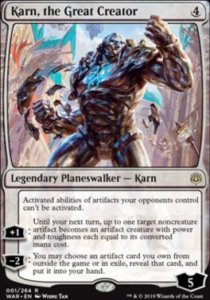
Karn is your best threat and answer to more or less everything, as long as you have enough mana. The wishboard have to be built with the metagame in mind. I like to have those rules in mind against each matchup:
- What’s your best cheap target? (up to three mana)
- What’s your best expensive target? (usually up to eight mana)
- What’s the second-best target in both cases?
The -2 ability is definitely the best ability of Karn, but shutting down artifacts’ activated abilities has a bunch of upside, and can shut down entire decks, like Hammer or Scales. Using the +1 (mainly targeting your own Ring) to have a free creature which can block for a turn or target the opponent’s artifacts (like Agatha’s Cauldron or Amulet of Vigor) to kill them with removal is common.
Nonetheless, it’s not the kind of planeswalker you have to protect, unless the static ability is key, as fetching an artifact and gaining some life is more than fine in most cases.
The One Ring
I will not argue why this card is good but, in my opinion, why Coffers is one of the best Ring decks.
- Drawing cards increases the power of March of Wretched Sorrow and Sheoldred
- Discard is the best way to force through your Ring
- Coffers make an absurd amount of mana, so you can cast more or less everything you draw
- Bowmasters, Karn and Sheoldred are good against other Ring decks
- Gaining life in various ways helps you to not die from your own Ring
- The deck can manage a large board of threats after you buy a turn with Ring’s protection, thanks to sweepers or Ensnaring Bridge
In many MUs, Rings is only an engine, which means drawing cards over multiple turns is not enough to win most of the time and you need specific tools to win. But against some decks, resolving it is probably half of the work you need to do.
- Ring as an engine: Yawgmoth, Domain decks, Tron, Burn, Control, Coffers, Scales, Rhinos, Living End, Amulet Titan
- Ring as a payoff: Scam, Murktide, Hammer
It leads to the choice of four maindeck Rings, because most of the time it’s an engine, not a payoff. Moreover, when it’s a payoff, it has a direct correlation with the matchup being quite good for Coffers.
When you play another Ring while you already have one in play, there are some factors to look at:
- If you care about your life, keep the new one
- If you need to dig for cards and you have a bunch of life, keep the old one
- By default, do not be too greedy
Because of Orcish Bowmasters and Leyline Binding being commonly played, keep the following in mind:
- Wait until the ETB trigger resolves before drawing any cards
- Activate during the opponent’s upkeep if you can’t play anything at sorcery speed
- Play discard before activating to draw in response to the potential answer
- You can activate Ring and use March with Bowmasters triggers on the stack.
Don’t forget that most of the time, you should probably just activate immediately to play something at sorcery speed, do not value being smart over being efficient.
Sheoldred, the Apocalypse
Currently, Sheoldred is a good modern card instead of being a corner case threat that happens to work well with the Ring. Not dying against a Bolt, dealing damage through The One Ring and/or without attacking, and gaining life against aggressive decks are relevant upsides. From my point of view, this card is mostly a finisher/stabiliser when you have the Ring out and, in some matchups, the raw power of the card is enough to take over. At this point, I tend to prefer Cling to Dust because the most needed use of lifegain is to stabilise with a Ring, and Cling is more mana-efficient and safer to cast. If you already have Sheoldred in play and your opponent is waiting to have a perfect window, don’t forget to play discard first to make them move first before you use Cling to Dust or draw with the Ring.
Interactive cards
Orcish Bowmasters

I think this is the strongest card in the deck in terms of raw power, and you need a seriously good reason to not put this card in your deck if you already play black cards. The card simply does everything: it’s a removal with different modes (you can ping Ragavan, enemy Bowmasters, or a larger creature and then block with both Orcs, or just a planeswalker that’s low) and a hate card against the Ring. Do not forget to play it at the right time, instead of focusing on those “gotcha” windows. For example, on sorcery speed against The One Ring, if you want to be sure to not offer a way to play around at instant speed to your opponent, or against Ragavan to respect cards like Not Dead After All or Counterspell. A couple of usual tricks are to kill Orcs themselves to feed the graveyard or get Revolt, or to get a target for March.
Thoughtseize
When you play Coffers, there are a low number of cards which you can’t win against on board. Because of that, discard serves two purposes: protecting your own payoffs (discard Bowmasters before casting the Ring, discard removal before casting Sheoldred, discard artifact hate before casting a Karn and getting a crucial artifact, etc.) and interacting against noncreature-based strategies. As long as one of those is needed, then discard will be effective. At this point I think Scam is more or less the only deck against which discard is mediocre, as you only care about slowing them down with the discard if your removal doesn’t line up well against their threats. Thoughtseize is the best discard spell because you need to discard both creatures (Bowmasters, Sheoldred, Shardless Agent, Yawgmoth, Grist, Ulamog) and noncreature spells (Leyline Binding, Ring, planeswalkers, counterspells) very often. There is not so obvious balance around your life points, but playing with multiple ways to gain life you can safely run a full playset, especially with decks like Burn or Prowess on decline.
Inquisition of Kozilek
Now that the decklist probably contains four Thoughtseizes, the question of extra discard can be asked. First of all, I would not play Duress in the maindeck because you need to hit against everyone during game one. At least in my own decklist, I think the best play pattern available to Coffers is to cast a discard spell then a Karn or a Ring, as most of the time those haymakers can beat a lot of opponent’s threats and you mostly care about them resolving with a lack of specific resources on your opponent’s part during their next turn. The second reason is that hard matchups of Coffers are mostly based around cheap unfair cards (Amulet of Vigor, Shardless Agent, Force of Negation, Underworld Breach), and a part of your plan is to hope they don’t have a great opening.
Fatal Push
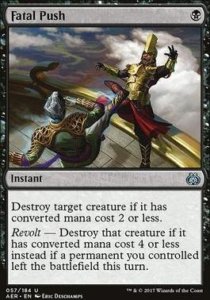
Currently one of the best removal spells of the format, it covers most of the threats you can play against. Field of Ruin and legendary permanents can enable Revolt when needed, but being able to efficiently deal with Ragavan, Bowmasters or Wall of Roots is far enough to like it. At this point, playing four is a no-brainer, especially given that your other options are either more situational or more expensive.
Bloodchief’s Thirst/Defile
Like Inquisition of Kozilek with Thoughtseize, they can be seen as extra copies of Fatal Push. Dealing with Ragavan is probably the most important aspect of them – you’re not especially afraid of the card, but many losses against Ragavan decks start with a turn one monkey. Those cards have some big restrictions, so I could only see them played if you need to kill Halfling, Bowmasters and Ragavan more often than usual.
March of Wretched Sorrow
This is not a good modern card at all, but it’s mandatory to play at least three of them in this deck, and four if the metagame is full of decks which aim to kill you in combat. Even though it has a low power level, the card is very flexible, and you can kill cheap stuff like for one mana by pitching a card if needed. When the game goes longer, you can use Coffers or cards drawn with the Ring to scale it up. The ability to kill planeswalkers is not very relevant at the moment, but the card allows you to stabilise very quickly when you use The One Ring, as you don’t have something like Teferi to reset it. Instant speed is important, as you will often cast it with the Ring’s trigger on the stack. The main aim of Coffers is to gain time, and this card gives you an extra turn very efficiently. In some scenarios, killing your own stuff with it is required to avoid dying.
Sheoldred’s Edict
A good extra removal if you care about planeswalkers or Scion of Draco with Leyline of the Guildpact. Otherwise, I think the downside of not being able to kill a particular thing you care about is a major issue when you need to stabilise after turn two. It can be a fine SB removal with a couple of specific matchups where it’s great.
Damnation
The main purpose of this card is as a one-of if you play Profane Tutor, as suspending it on turn 2 will yield a turn 4 sweeper if we really need to clean the board without spending a turn to set up payoffs or play The One Ring. Killing multiple creatures is something you want to do in numerous matchups, but we are far from winning the game straight up and a good part of decks don’t care about it (Mill, Burn, Tron, Control, Omnath) or can generate another powerful board (Living End, Rhinos, Amulet Titan, sometimes Yawgmoth). I won’t say the card is bad, but the deck should not rely too much on it. It’s an average interaction, rarely a payoff.
Deadly Cover-Up
You have to pay one more mana compared to Damnation, and exile cards from your graveyard, to get an Extraction effect that doesn’t target, so you can extract a creature destroyed by Deadly Cover-Up. Against decks which are not hurt that much by a sweeper, it’s a bit better than Damnation because it gives you access to an Extraction effect, even if it’s a very bad one. In matchups low on creatures, you often want to resolve multiple discard spells and The Stone Brain to dismantle your opponent, and Deadly Cover-Up can act as a substitute for Stone Brain in some cases. It’s not very impressive in that role, but at least a bit better than Damnation. The major upside of it is against decks that try to win by putting creatures in play and can recover from a sweeper. These decks have the common aspect of relying heavily on one or two specific cards, for example Living End, Crashing Footfalls, Yawgmoth and Primeval Titan. So, instead of using the wrath as an interaction and then trying to win, you can set up Deadly Cover-Up and then more or less win by resolving it with the Extraction effect on the right card. This one effect transforms the sweeper from an interaction to an interaction which is often a payoff.
The rest
Cling to Dust
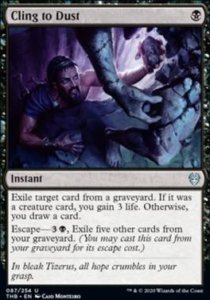
The main purpose of this card is to smooth your draws. In the early game, it tags mainly noncreature cards to draw and sometimes disrupt cards like Wrenn and Six, Dragon’s Rage Channeler or Murktide Regent, then later in the game, it can be used to stabilise your life total when Ring and Coffers are assembled. Sometimes, it’s useful to have it as a graveyard hate against the opponent’s best openings (fast Goryo, early Cauldron on Grist/Yawgmoth, scammed Grief or Living End reanimating Grief on turn three). Against other fair decks, being a slow card advantage spell is powerful enough to allow you to dig for your haymakers. I’m not an advocate of playing four in the main deck, because having two of them in the opening hand can lead to poor sequencing if you’re tight on mana. However, two copies in the maindeck feels like a minimum, and adding another one after you board out many poor interactive cards is a way to respect aggressive and graveyard strategies.
Profane Tutor
Its purpose is to help to set up your mid game most of the time, because in many matchups the best you can do is double spelling interaction with a haymaker in the same turn. Because Profane Tutor can fetch anything, that means you may get Urborg or Coffers with it. However, 26 lands with some cantrips is enough to have four or five lands most of the time and can easily lead to flooding, so fetching for an extra proactive card and setting up a gameplan in advance could be safer. Profane Tutor adds protection against discard and counterspells (because you can fetch for a discard). Being a suspend spell means two things: you can use the Ring while the trigger is still on the stack before fetching a card, and you have to care at least a little about the Cascade hate like Chalice of the Void, Lavinia, Tishana’s Tidebinder or Teferi, Time Raveler. Note that if your opponent plays Cascade hate, they probably cast something bad against your deck overall or they may tap out before your fourth turn.
Night’s Whisper
A good choice if you want to be more proactive. It helps dig for important cards, but facing many aggressive strategies, fast decks and Bowmasters make the card poor pretty often. Coffers isn’t a deck defined by card advantage, as you mostly want the right card at the right time. Night’s Whisper is tempo-negative, isn’t flexible and it’s not a very powerful draw spell by itself. I recommend playing Profane Tutor if you want a cheap way of digging, otherwise interaction spells with a cantrip feel better.
Shadow of Doubt
You should only play this card if you expect a lot of decks with tutors (Urza’s Saga, Tron decks), or decks with a lot of fetches that need to hit specific land drops (Cascade decks, Four Colour and other slow Ring decks). Shadow of Doubt forces you to make some sacrifices in the manabase, because double black mana on turn two requires around 18/19 sources. It’s decent to cut some copies of Field of Ruin in that case, because Shadow of Doubt sometimes fulfils a similar purpose (against Tron lands and Urza’s Saga mainly). It’s a cantrip too, so do not hesitate to just cycle it. Coffers is not a “gotcha” deck, and in the lategame you can turn your Field of Ruin into Wasteland (kind of) by casting it before activating your land.
Invoke Despair/Archon of Cruelty/Emrakul, the Promised End/Torment of Hailfire/etc
Examples of some former tools used before the printing of The One Ring and Sheoldred to make use of Cabal Coffers, at this point the reason to not play them is just the power creep. Emrakul, the Promised End is by far the best one among those cards, because many current archetypes can kill themselves pretty easily (Yawgmoth, Summoner’s Pact, having a low amount of payoffs with counterspells like Cascade). I don’t recommend those except if a specific scenario keeps recurring in multiple matchups when you start using The One Ring, or if you play Profane Tutor.
Sideboard options
Karn’s wishboard
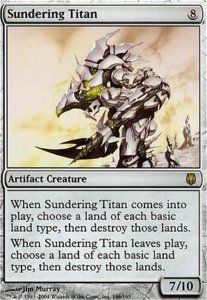
First thing is deciding how many silver bullets we need. I don’t have a fixed number, but I’m always trying to meet following criteria:
- Do I need a specific target for this match-up?
- Do I have a cheap target to fetch in this match-up?
- Do I have a good target to fetch in this match-up when I have a lot of mana?
- Do I have a second good target after I fetched the first one?
Two examples:
- Against Murktide: I don’t really need a specific target because the matchup is quite good. I can get a piece of graveyard hate or Ensnaring Bridge when low on resources, and Cityscape Leveler, Sundering Titan, Wurmcoil Engine, and Oblivion Stone are all good when I have 6+ mana. Considering the high amount of good targets, having a second relevant one is easy.
- Against Mill: I need a specific target because the mu seems quite rough and the usual KGC wishboard cards are mediocre. Elixir of Immortality is the only useful cheap card, and, if you have a lot of mana, looping The Stone Brain or casting Sundering Titan is fine. The Stone Brain is a fine second target, mostly to extract any counterspell before casting Elixir.
As long as your answer isn’t “I have no targets for this matchup, but I need one”, you should be fine. Matchups aside, another important question is this: do I commonly face a situation where I have access to Karn, but I’m dead on board nonetheless (mostly because of the Ring)? If so, then cards like Elixir of Immortality of Phyrexian Metamorph could be interesting to stabilise with an active Ring. The more lifegain you run in the maindeck, the less you need in your wishboard, and the card choice after that depends on the small upsides (Elixir against Burn and Mill, Metamorph to get another turn of protection).
Boarding in your silver bullets is pretty uncommon. I identify 3 cases:
- Your interaction is quite poor, and you already have a couple of good targets to grab with Karn, so you can board a couple of cards. (The Stone Brain against blue control decks, Chalice against Amulet Titan)
- Your opponent plays Karn as well, and you already have a couple of things you need to grab to deal with their wishboard. (Wurmcoil Engine in the mirror match, Walking Ballista against Tron)
- Your opponent plays Pithing Needle postboard and you really need Ring or Karn to win the game, so you can board in cards which destroy Pithing Needle (Engineered Explosives and/or Oblivion Stone against Hammer, Scales and Urza’s Saga midrange). Seems unnecessary at the very least with a maindeck Blast Zone.
Besides theorycrafting, it’s very important to remember to draw a line at some point. You can’t have something for every specific situation you will face, and I think it’s quite consensual that Coffers can’t have a 15 card wishboard, because you’re not proactive enough to just ignore certain matchups in sideboarding and hope that Karn will bail you out in time.
The One Ring
A large number of decklists still play the fourth copy in the sideboard. I think that’s a mistake, because The One Ring is an engine tool in Coffers and rarely a payoff. Moreover, Coffers are not like Tron decks, and we can’t consistently play Karn and get the Ring by turn four, and then have an overabundance of mana to do something else with Karn.
Threats
Cityscape Leveler
One of the best creatures to finish the game quickly. It’s your best target when you’re facing another Karn deck, discard or counterspell. I could see it removed if there are no other Karn decks at all and there is already a good target against Leyline Binding decks.
Sundering Titan
It’s pretty often the best target against non-aggressive domain decks like UW Control, Four Colour Omnath and Creativity. It’s a powerful tool against Tron, mirror match, Yawgmoth and combo decks (thanks to Urborg which turns each land into swamp) where attacking their mana can win you the game in a safe way, instead of needing to fade opposing topdecks.
Wurmcoil Engine
Great pick when you play “small games” (mostly comes up against Scam and Murktide), or when you start caring about your life total at least a couple of turns before The One Ring kills you (Burn or Rhinos for example). It’s one of the cards you board in most often, and it’s a choice quite close to Phyrexian Metamorph and Elixir of Immortality.
Removal and hate cards
Ensnaring Bridge
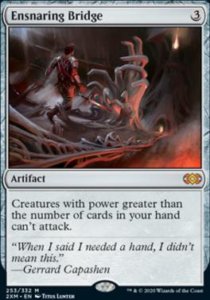
When you just need to stay alive, this is the target you are looking for. It’s pretty rare to fetch it first, because many decks can destroy it or go under when they have resources, and you usually get it when your opponent is trying to close out the game. It’s your best target against Scam. Remember Cityscape Lever can destroy it when you need to finish the game. You can also deal with it by animating it with Karn and then killing it, or just by drawing enough cards with The One Ring.
Oblivion Stone
If you have enough time, Stone is often better than Ensnaring Bridge, because resetting the board is often more valuable than just not being attacked. However, it’s a much more costly option that also leaves more room for counterplay, so it should be seen as a twelve mana spell (four mana for Karn, three for Stone and five for the activation). It allows you to deal with annoying stuff like Cauldron + Grist/Yawgmoth or Scion of Draco + Leyline of the Guildpact. I currently see it as the best card from the wishboard.
Engineered Explosives
The mainstream sideboard card to deal with tokens, its purpose is the same as usual here. It’s a good target against Urza’s Saga decks because you care about Pithing Needle, Hardened Scales, Colossal Hammer, Sigarda’s Aids and Amulet of Vigor. One of the most sideboarded artifacts.
Chalice of the Void
Mostly a hate card for Cascade. It has many secondary uses against Burn, Prowess, Amulet, etc., but that’s a mediocre target in those cases for the same reason why I don’t like it even against Cascade. Because it’s in the wishboard, you need to resolve Karn first, and hope that your opponent didn’t cast their relevant spells before Chalice was deployed. It’s awfully difficult to do that against Cascade decks, and not that much easier against Amulet or Monastery Swiftspear decks.
The Stone Brain
This card is a bit weird, as it feels like an auto-inclusion in any Karn deck, but it’s almost never your first target. It’s good mostly because there are many games where you can deal with a lot of stuff your opponents throw at you (Ensnaring Bridge in play, a bunch of life and resources etc.), but you know you could struggle if they draw something specific. In some matchups, only few cards are relevant, so getting The Stone Brain to exile them quickly is a good gameplan (Karn, Ring, Yawgmoth and Bowmasters, just to name a few).
Cursed Totem
A specific tool against Yawgmoth and basically only it. If your maindeck interaction isn’t good enough to clear their board, Cursed Totem is a way to gain a couple of turns to grab something more powerful. Many creatures can be affected by it of course, but most of the time stuff like Ensnaring Bridge, Engineered Explosives or Walking Ballista could easily do the job.
Elixir of Immortality
A cheap hate card against Mill and Burn, where Karn is usually quite poor against those decks. It’s one of the cards which helps you to stabilise while you have an active Ring too. Probably not worth it if none of the aforementioned decks are popular.
The rest
Liquimetal Coating
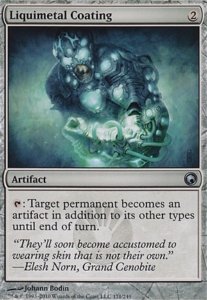
At first glance, it can be similar to the brutal play pattern known from Tron of Karn finding the Coating to freeze and then destroy a land every turn. However, the major difference is Coffers can’t do that consistently before turn five (turn four is possible but not realistic), so it’s not really an early play. The goal of the card is to destroy lands in the mid/lategame, so you only want it in matchups where you can buy some time and then use that repeated Stone Rain effect. Damping Sphere could be better in that mana denial spot, but it’s more specific against Amulet Titan and Tron, and both cards seem a bit too slow anyway.
Walking Ballista
This card tends to be seen as a “finisher”, because you can kill your opponent in one turn with an absurd amount of mana, that’s something you don’t need to accomplish at all. Sundering Titan, Wurmcoil Engine or Cityscape Leveler are powerful enough finishers. Walking Ballista is quite interesting as a way to get you a nice chump block for cheap (block something and ping another creature), a job which can often be done by Ensnaring Bridge. I think it’s an outdated wishboard card at this point.
Tormod’s Crypt
In the current metagame, it serves a similar role to Chalice of the Void. It’s a good card against Living End and Reanimator, but a bit too slow to grab with Karn. You need to interact a lot with them to slow the game enough for Karn to matter.
Phyrexian Metamorph
A similar card to Elixir of Immortality and Wurmcoil Engine, because it allows you to stabilise with an active Ring. Its purpose is to chain Rings with Karn, or you can sometimes copy something relevant (like putting a second Ensnaring Bridge in play, copying Sheoldred or Primeval Titan).
Sideboard options that are not in the wishboard
Leyline of the Void
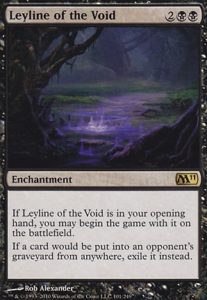
An unconditional graveyard hate with the well-known downsides. Decks like Living End, Yawgmoth or Reanimator are very used to dealing with those hate cards: keeping a weaker opening hand, drawing bricks and showing your opponent how to adapt their gameplan against a slow deck are a bit too much in my opinion. Other cards can attack those decks without the same downsides.
Dauthi Voidwalker
The card I prefer over Leyline of the Void because it’s better than Leyline of the Void against Living End. Their only good answer is Subtlety and you can play a discard before, or discard your own Dauthi. Nonetheless, the advantage of Dauthi Voidwalker is being useful against a bunch of decks because it provides a clock (shifting of gameplan), enables absurd turns and attacks planeswalkers. With so many matchups where our maindeck interaction can be mediocre, having a versatile hate card is a good place to be.
Necromentia
A good pick against decks which rely on a certain card. If your maindeck interaction can’t handle something, that means Necromentia is probably good against it. It’s not a flawless fix at all, because many times the issue you face is lack of time, and Necromentia can be too slow, especially on the draw, but it’s a fine first payoff or a way to buy more time after an early discard at least.
Collective Brutality
It’s not really a hate card because Burn is not popular, nor a very scary matchup. Collective Brutality is mostly a general good interaction to replace a mediocre discard or removal postboard. It’s a good way to discard Voidwalker early against Living End, feed Cling to Dust, kill Bowmasters or use an extra Urborg in hand.
Extra copies of MD cards (Cling to Dust, Damnation, Deadly Cover-Up, Inquisition of Kozilek, etc)
I admit it’s a bit of a weird category, but with Karn giving us so many tools usually unavailable to mono black decks, we rarely need specific tools in the sideboard. The idea is to slightly adapt the numbers of your best interaction spells and remove the worst ones.
Gameplay
General gameplan
Coffers are all about buying time to cast your stuff. You don’t care about being fast or putting pressure from the get go, just about prolonging the game. It comes from the fact Coffers can go over the top of any other deck in Modern (at least among popular ones):
- Discard win against counterspells, which makes resolving lategame payoffs easier.
- Karn, Ring and sweepers can win against fair decks on their own.
- The Stone Brain, Liquimetal Coating, Field of Ruin and Sundering Titan provide a way of dealing with linear decks.
Only decks like UW, Four Colour and Tron can fight at the same level of inevitability.
I think the deck is pretty easy to play once you internalise this lesson. It’s not a grindy deck, it doesn’t care about incremental card advantage, but about reaching its inevitable endgame.
Mulliganing
When you don’t know what your opponent is playing game one, you should focus on having a functional hand, i.e. you can cast most of your spells, which means access to black mana and at least 2 lands other than Coffers without an Urborg, as well as some early interaction.
Once your starting hand is functional, you can take a closer look at what exactly your interaction covers. The quality of your lands is another point to consider, if you already get Urborg + Coffers you could keep with fewer nonland cards because any of your payoffs will be better. Considering how rigid and reactive of a deck Coffers is, you have to gamble many times on your hand, for example hoping that your removal is useful or that you can draw a payoff in the right time frame. After sideboarding, you know what you need to focus on, and you can keep and search for more polarised hands. Don’t forget the deck has a high land count, so it’s fine to keep 2 landers most of the time as long as you have at least a couple pieces of interaction. A couple of remarks about specific lands:
- If you have multiple Urborgs in the opening hand, the second Urborg can be seen as a fine fourth land drop (because of Karn/Ring) but not a second or third
- Coffers can be seen as a land only if you have Urborg, otherwise, it should not count in your starting hand
- Field of Ruin, Demolition Field and Troll of Khazad-dûm are a second land if you have a black source, otherwise I wouldn’t count them
I’m a fan of the following approach: if your hand is perfect by replacing one of your cards, that’s probably a keep, as long as the two lands requirement is met.
Mulliganing – examples
Hand 1

OTP/OTD, 7 cards, unknown matchup: 1 Swamp, 1 Urborg, 1 Cabal Coffers, 1 Thoughtseize, 1 The One Ring, 1 March of Wretch Sorrow, 1 Field of Ruin
Snap keep. It’s basically the perfect hand: removal, discard, mana engine, mana denial and a payoff.
Hand 2

OTP/OTD, 7 cards, unknown matchup: 1 Field of Ruin, 1 Troll of Khazad-dûm, 1 Cabal Coffers, 1 Cling to Dust, 1 Karn, the Great Creator, 1 Deadly Cover-Up, 1 Shadow of Doubt.
Snap mulligan. Despite doing something, this hand neither interacts early nor casts a payoff in the midgame.
Hand 3

OTP/OTD, 7 cards, unknown matchup: 2 Urborg, Tomb of Yawgmoth, 1 Field of Ruin, 1 Swamp, 1 Fatal Push, 1 Thoughtseize, 1 Shadow of Doubt.
Keep. There’s no payoff, and the second Urborg is a bit mediocre, but you have access to plenty of interaction. You can cast either Karn or Ring on turn four if you draw them, even if you don’t find more lands.
Hand 4

OTP/OTD, 7 cards, unknown matchup: 1 Orcish Bowmasters, 2 Fatal Push, 1 March of Wretch Sorrow, 1 Urborg, Tomb of Yawgmoth, 1 Swamp, 1 Deadly Cover-Up.
Mulligan. This hand will be good against decks like Scam or Murktide, but very often it will struggle against any linear strategies, or even something like Rhinos, because you don’t have neither mana nor payoff. However, it’s a keep on six cards.
Hand 5

OTD, 7 cards, unknown matchup: 1 Thoughtseize, 1 Inquisition of Kozilek, 1 Cling to Dust, 1 Swamp, 1 Cabal Coffers, 1 Fatal Push, 1 The One Ring.
Keep, mulligan OTP. This is the kind of hand I like OTD, because you can deal with the most openings, dig for a land and you already have a payoff. I think discards are worse OTP here because you have slim chances of playing turn four Ring.
Hand 6

OTP, 6 cards, unknown matchup: 1 Urborg, Tomb of Yawgmoth, 1 Cabal Coffers, 1 Swamp, 2 Shadow of Doubt, 1 The One Ring.
Snap Keep, mulligan OTD. Shadow of Doubt is a good piece of interaction on the play, and helps you dig for the fourth land. Slowing down the opponent then playing The One Ring with active Coffers is close to the best case scenario for any hand.
Hand 7

OTD, 7 cards, against Amulet: 1 Fatal Push, 1 Field of Ruin, 1 Orcish Bowmasters, 1 The One Ring, 1 Urborg, Tomb of Yawgmoth, 1 Cabal Coffers, 1 Troll of Khazad-dûm.
Snap mulligan. The only relevant interaction is destroying a bounceland on turn three and pushing Dryad of the Elysian Grove, which is quite weak considering they can often have Primeval Titan in play at this point. Look for a good interaction against them with mana to cast it.
Hand 8

OTP, 7 cards, against 4C Omnath: 1 Field of Ruin, 2 Orcish Bowmasters, 1 March of the Wretch Sorrow, 1 Karn, the Great Creator, 1 Swamp, 1 Cabal Coffers.
Keep. Not a great one, but it’s one of the few matchups where being proactive has some value, because they can beat you in the lategame. Bowmasters can pressure their planeswalkers, and Karn will fetch a payoff once you get more Swamps.
Hand 9

OTD, 7 cards, against Murktide: 2 Swamps, 1 Thoughtseize, 2 The One Ring, 1 Field of Ruin, 1 Deadly Cover-Up.
Mulligan. In the matchups where the opponent usually struggles against your removal, they have to prioritise aggressive openings, so keeping a hand that can’t interact with the board seems like a poor idea. It’s a keep on the play, since you can Thoughtseize their one drop.
Hand 10

OTP, 7 cards, unknown matchup: 1 Fatal Push, 1 Field of Ruin, 2 Profane Tutor, 1 Urborg, Tomb of Yawgmoth, 1 Thoughtseize, 1 Swamp.
Snap keep. This is basically the perfect hand for the Tutor version, being OTP with interaction on all axes, and double Tutor to cover all your needs.
Hand 11

OTD, 7 cards, unknown matchup: 1 Field of Ruin, 1 Karn, the Great Creator, 1 The One Ring, 1 Profane Tutor, 1 Cabal Coffers, 1 Troll of Khazad-dûm, 1 Damnation.
Mulligan. This hand looks playable and that’s where the trap is if you want to keep it. You can’t interact with your opponent at all until turn three, unless you draw a discard spell quickly. Skipping a turn to get a black source is not a big deal 90% of the time, but it’s an issue here, since it makes a topdecked Thoughtseize much worse on turn one.
Sequencing
Lands:
- Hold Takenuma for as long as possible
- Don’t play Urborg before turn three unless it’s needed to cast a spell or if you need to use Field of Ruin on turn three
- Play Field of Ruin first if your next land is Urborg
- Play Coffers as late as possible if your opponent is afraid of Karn or plays counterspells
- Be mindful of the opponent’s mana denial if you have Urborg and Cabal Coffers in play, and do not play a bunch of non-Swamps unless they’re useful
- Playing a second Urborg can be a way to bluff a Fatal Push, Cling to Dust or any other cheap spell
Discard:
- Start with Inquisition of Kozilek most of the time, unless you play against a cascade deck or basically any deck where you may face Leyline Binding, or a landcycler, and you want to save Inquisition to get Force of Negation later on
- You don’t need to play discard first if you’re not afraid of anything on your opponent’s turn
- If you have enough time, slowrolling your discard to pave way for your payoff is quite good
Removal:
- Start by using Fatal Push over March of Wretched Sorrow unless you need the lifegain
- If you don’t need all your mana next turn, you can often wait to see if you draw a better removal spell, like Bowmasters against Ragavan, or March + pitching your first removal against Burn
- If you’re about to chain a bunch of Rings into a sweeper, there’s no need to deal with every single creature prior to deploying your first Ring
Payoffs:
- Once you identify your best payoff in the matchup, you can try to bait interaction with other cards
- Doing nothing on a turn where you have enough mana for a payoff may misinform your opponent and make them develop their board in a greedier way
- Using payoff to buy time is pretty good if you know they have answers to it, or if you need more mana to cast a better payoff
Be aware that Shadow of Doubt turns off the swampcycling from Troll of Khazad-dûm, so don’t offer a window to your opponent to fetch while you have the swampcycling on the stack if you need this land. It could be a good way to bait their fetch though, so thinking a little about the situation before cycling at the right time is needed.
Activating Field of Ruin and Demolition of Field is at its best in the opponent’s upkeep or draw step, because it’s more difficult to efficiently use the extra mana in these steps. Make sure that using Field isn’t actually helping them with their colours.
As far as The One Ring goes, you should activate it when you need to do stuff in your own turn, otherwise you should wait until your opponent’s upkeep to respect cards like Orcish Bowmasters, Leyline Binding, Tear Asunder or Tishana’s Tidebinder. You have to analyse every single of these cards on their own and try to pick the best moment to activate your Ring. Some classic ones:
- If you expect Bowmasters, wait until their upkeep or cast a discard first.
- If you expect Leyline Binding, wait until their upkeep or activate Field of Ruin to make it more expensive.
- If you expect Tishana’s Tidebinder, wait until their upkeep, or their end step if you want them to tap out
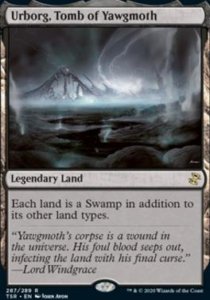
Tips and tricks
- Karn, the Great Creator can unequip any equipment if you use the plus ability on it and allows you to kill any noncreature artefact with a removal spell
- Shadow of Doubt can turn a Field of Ruin/Demolition Field into a Wasteland
- Shadow of Doubt will prevent searching the library from The Stone Brain and Necromentia
- March of Wretched Sorrow can target your own creatures and planeswalkers to gain life
- The One Ring can draw enough cards to attack under your Ensnaring Bridge, then you can spend your cards to turn it back on against your opponent’s creatures
- Playing a second Urborg triggers revolt for Fatal Push
- Urborg turns any opponent’s land into a Swamp, so Sundering Titan can destroy it
- Urborg still makes other lands into Swamps if named with Alpine Moon, but it won’t be a Swamp itself
- Cabal Coffers can convert colourless mana into black even if you have 1 or 2 Swamps in play
- Orcish Bowmasters can kill themselves to feed Cling to Dust at instant speed
- If you play Profane Tutor, you can stack it after The One Ring’s upkeep trigger to see what to fetch after using your Ring
- Profane Tutor can search for another Profane Tutor, which is relevant if you have time (at least two turns), no great targets (usually because your fourth land is missing) and you want to play around discard and/or counterspells
- The Stone Brain can force your opponent to draw, which can be useful with Bowmasters or Sheoldred in play.
- Cityscape Leveler will make a free Powerstone if you target your own Ring
- Targeting yourself with discard can be useful with Ensnaring Bridge, Cling to Dust or Dauthi Voidwalker against specifically Living End
